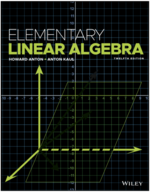?Assuming that the stated inverses exist, prove the following equalities.a
Chapter 1, Problem 24(choose chapter or problem)
Assuming that the stated inverses exist, prove the following equalities.
a. \(\left(C^{-1}+D^{-1}\right)^{-1}=C(C+D)^{-1} D\)
b. \((I+C D)^{-1} C=C(I+D C)^{-1}\)
c. \(\left(C+D D^{T}\right)^{-1} D=C^{-1} D\left(I+D^{T} C^{-1} D\right)^{-1}\)
Partitioned matrices can be multiplied by the row-column rule just as if the matrix entries were numbers provided that the sizes of all matrices are such that the necessary operations can be performed. Thus, for example, if 𝐴 is partitioned into a 2 × 2 matrix and 𝐵 into a 2 × 1 matrix, then
\(\mathrm{AB}=\left[\begin{array}{ll} A_{11} & A_{12} \\ A_{21} & A_{22} \end{array}\right]\left[\begin{array}{l} B_{1} \\ B_{2} \end{array}\right]=\left[\begin{array}{l} A_{11} B_{1}+A_{12} B_{2} \\ A_{21} B_{1}+A_{22} B_{2} \end{array}\right] \)
provided that the sizes are such that 𝐴𝐵, the two sums, and the four products are all defined.
Equation Transcription:
AB=[][
] = [
]
Text Transcription:
(C^-1+D^-1)^-1=C(C+D)^-1 D
(I+CD)^-1C=C(I+DC)^-1
(C+DDT)^-1D=C^-1D(I+DTC^-1D)^-1
AB=[A_21 A_22 A_11 A_12][B_2B_1] = [A_21B_1+ A_22B_2A_11B_1+ A_12B_2]
Unfortunately, we don't have that question answered yet. But you can get it answered in just 5 hours by Logging in or Becoming a subscriber.
Becoming a subscriber
Or look for another answer
